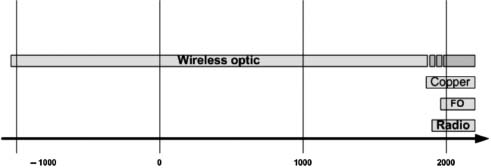Chapter 3
The Contemporary and the Everyday Life of Wireless Optical Communication
“2010 is the beginning of the decade of wireless optical communications” Dr Larry B. Stotts,Defense Advanced ResearchProjects Agency (DARPA),IEEE Spie Optics & Photonics,San Diego (USA), August 2009
3.1. Basic principles
The wireless optical communication systems were the first to be used (Figure 3.1) and, due to technological innovations, they become attractive, mainly because of the lack of produced or suffered radio interference and, especially, from the ever-increasing demand of the data rate.
Before presenting the daily and contemporary applications of wireless optical communication, we define some basic principles and the different modes of propagation.
3.1.1. Operating principle
3.1.1.1. Block diagram
Wireless optical communications refer to the use of light propagation in the field of optics with free space as a transmission medium.
Figure 3.1. Communication history

An example of the principles of operation is detailed in Figure 3.2 with various technical modules present in an optical wireless in emission (Tx) and in reception (Rx). At the transmission (Tx), from digital data received by a computer or a server via a suitable interface (D-Tx), a digital and analog electronic processing (El-Tx) is performed to adapt the signals to electrical-optical converter (Ot-Tx). This converter is ...
Get Wireless Optical Telecommunications now with the O’Reilly learning platform.
O’Reilly members experience books, live events, courses curated by job role, and more from O’Reilly and nearly 200 top publishers.

